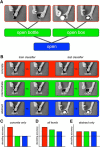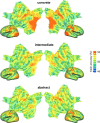Decoding actions at different levels of abstraction
- PMID: 25995462
- PMCID: PMC6795187
- DOI: 10.1523/JNEUROSCI.0188-15.2015
Decoding actions at different levels of abstraction
Abstract
Brain regions that mediate action understanding must contain representations that are action specific and at the same time tolerate a wide range of perceptual variance. Whereas progress has been made in understanding such generalization mechanisms in the object domain, the neural mechanisms to conceptualize actions remain unknown. In particular, there is ongoing dissent between motor-centric and cognitive accounts whether premotor cortex or brain regions in closer relation to perceptual systems, i.e., lateral occipitotemporal cortex, contain neural populations with such mapping properties. To date, it is unclear to which degree action-specific representations in these brain regions generalize from concrete action instantiations to abstract action concepts. However, such information would be crucial to differentiate between motor and cognitive theories. Using ROI-based and searchlight-based fMRI multivoxel pattern decoding, we sought brain regions in human cortex that manage the balancing act between specificity and generality. We investigated a concrete level that distinguishes actions based on perceptual features (e.g., opening vs closing a specific bottle), an intermediate level that generalizes across movement kinematics and specific objects involved in the action (e.g., opening different bottles with cork or screw cap), and an abstract level that additionally generalizes across object category (e.g., opening bottles or boxes). We demonstrate that the inferior parietal and occipitotemporal cortex code actions at abstract levels whereas the premotor cortex codes actions at the concrete level only. Hence, occipitotemporal, but not premotor, regions fulfill the necessary criteria for action understanding. This result is compatible with cognitive theories but strongly undermines motor theories of action understanding.
Keywords: MVPA; action concepts; action understanding; fMRI; motor system; occipitotemporal cortex.
Copyright © 2015 the authors 0270-6474/15/357727-09$15.00/0.
Figures




Similar articles
-
Decoding Concrete and Abstract Action Representations During Explicit and Implicit Conceptual Processing.Cereb Cortex. 2016 Aug;26(8):3390-3401. doi: 10.1093/cercor/bhv169. Epub 2015 Jul 28. Cereb Cortex. 2016. PMID: 26223260
-
MEG Multivariate Analysis Reveals Early Abstract Action Representations in the Lateral Occipitotemporal Cortex.J Neurosci. 2015 Dec 9;35(49):16034-45. doi: 10.1523/JNEUROSCI.1422-15.2015. J Neurosci. 2015. PMID: 26658857 Free PMC article.
-
Action Categories in Lateral Occipitotemporal Cortex Are Organized Along Sociality and Transitivity.J Neurosci. 2017 Jan 18;37(3):562-575. doi: 10.1523/JNEUROSCI.1717-16.2016. J Neurosci. 2017. PMID: 28100739 Free PMC article.
-
Surface-based information mapping reveals crossmodal vision-action representations in human parietal and occipitotemporal cortex.J Neurophysiol. 2010 Aug;104(2):1077-89. doi: 10.1152/jn.00326.2010. Epub 2010 Jun 10. J Neurophysiol. 2010. PMID: 20538772 Free PMC article.
-
The lateral occipitotemporal cortex in action.Trends Cogn Sci. 2015 May;19(5):268-77. doi: 10.1016/j.tics.2015.03.006. Epub 2015 Apr 3. Trends Cogn Sci. 2015. PMID: 25843544 Review.
Cited by
-
Semantic Activation in Badminton Action Processing and Its Modulation by Action Duration: An ERP Study.Brain Sci. 2022 Oct 27;12(11):1458. doi: 10.3390/brainsci12111458. Brain Sci. 2022. PMID: 36358384 Free PMC article.
-
A parietal region processing numerosity of observed actions: An FMRI study.Eur J Neurosci. 2020 Dec;52(12):4732-4750. doi: 10.1111/ejn.14930. Epub 2020 Aug 10. Eur J Neurosci. 2020. PMID: 32745369 Free PMC article.
-
Position and Identity Information Available in fMRI Patterns of Activity in Human Visual Cortex.J Neurosci. 2015 Aug 19;35(33):11559-71. doi: 10.1523/JNEUROSCI.0752-15.2015. J Neurosci. 2015. PMID: 26290233 Free PMC article.
-
Neurocognitive mechanisms underlying action tool knowledge tasks: specificity of tool-tool compared to hand-tool compatibility tasks.Commun Biol. 2025 Apr 3;8(1):552. doi: 10.1038/s42003-025-07923-1. Commun Biol. 2025. PMID: 40181134 Free PMC article.
-
Electrophysiological hallmarks for event relations and event roles in working memory.Front Neurosci. 2024 Jan 24;17:1282869. doi: 10.3389/fnins.2023.1282869. eCollection 2023. Front Neurosci. 2024. PMID: 38328555 Free PMC article.
References
-
- Benjamini Y, Yekutieli D. The control of the false discovery rate in multiple testing under dependency. Ann Stat. 2001;29:1165–1188. doi: 10.1214/aos/1013699998. - DOI
Publication types
MeSH terms
LinkOut - more resources
Full Text Sources
Miscellaneous
